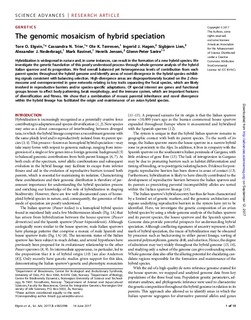| dc.contributor.author | Elgvin, Tore Oldeide | |
| dc.contributor.author | Trier, Cassandra Nicole | |
| dc.contributor.author | Tørresen, Ole Kristian | |
| dc.contributor.author | Hagen, Ingerid | |
| dc.contributor.author | Lien, Sigbjørn | |
| dc.contributor.author | Nederbragt, Alexander Johan | |
| dc.contributor.author | Ravinet, Mark Simon Paul | |
| dc.contributor.author | Jensen, Henrik | |
| dc.contributor.author | Sætre, Glenn-Peter | |
| dc.date.accessioned | 2017-10-25T11:15:22Z | |
| dc.date.available | 2017-10-25T11:15:22Z | |
| dc.date.created | 2017-06-21T12:02:57Z | |
| dc.date.issued | 2017 | |
| dc.identifier.issn | 2375-2548 | |
| dc.identifier.uri | http://hdl.handle.net/11250/2462077 | |
| dc.description.abstract | Hybridization is widespread in nature and, in some instances, can result in the formation of a new hybrid species. We investigate the genetic foundation of this poorly understood process through whole-genome analysis of the hybrid Italian sparrow and its progenitors. We find overall balanced yet heterogeneous levels of contribution from each parent species throughout the hybrid genome and identify areas of novel divergence in the hybrid species exhibiting signals consistent with balancing selection. High-divergence areas are disproportionately located on the Z chromosome and overrepresented in gene networks relating to key traits separating the focal species, which are likely involved in reproductive barriers and/or species-specific adaptations. Of special interest are genes and functional groups known to affect body patterning, beak morphology, and the immune system, which are important features of diversification and fitness. We show that a combination of mosaic parental inheritance and novel divergence within the hybrid lineage has facilitated the origin and maintenance of an avian hybrid species. | nb_NO |
| dc.language.iso | eng | nb_NO |
| dc.publisher | American Association for the Advancement of Science | nb_NO |
| dc.rights | Navngivelse-Ikkekommersiell 4.0 Internasjonal | * |
| dc.rights.uri | http://creativecommons.org/licenses/by-nc/4.0/deed.no | * |
| dc.title | The genomic mosaicism of hybrid speciation | nb_NO |
| dc.type | Journal article | nb_NO |
| dc.type | Peer reviewed | nb_NO |
| dc.description.version | publishedVersion | nb_NO |
| dc.source.volume | 3 | nb_NO |
| dc.source.journal | Science Advances | nb_NO |
| dc.identifier.doi | 10.1126/sciadv.1602996 | |
| dc.identifier.cristin | 1477874 | |
| dc.relation.project | Norges forskningsråd: 223257 | nb_NO |
| dc.relation.project | Norges forskningsråd: 221956 | nb_NO |
| dc.relation.project | Norges forskningsråd: 240557 | nb_NO |
| dc.description.localcode | Copyright © 2017 The Authors, some rights reserved; exclusive licensee American Association for the Advancement of Science. Distributed under a Creative Commons Attribution NonCommercial License 4.0 (CC BY-NC). | nb_NO |
| cristin.unitcode | 194,66,60,5 | |
| cristin.unitcode | 194,66,10,0 | |
| cristin.unitname | Senter for Biodiversitetsdynamikk | |
| cristin.unitname | Institutt for biologi | |
| cristin.ispublished | true | |
| cristin.fulltext | original | |
| cristin.qualitycode | 1 | |

